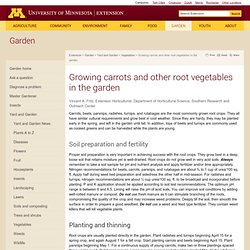

My One Fairy Tale Eggplant. July 23rd, 2010 Email 1 user recommends Can't wait to bring my Fairy Tale Eggplant into the kitchen. Photo by amy b under the Creative Commons Attribution License 2.0. While I had planned on growing several different varieties of eggplant this season, I ended up with only one in my front garden bed. The only eggplant that I've eaten are the ones that someone else has prepared for me. Eggplant 'Fairy Tale' Plant Care & Growing Information. Fairy Tale is a variety of Eggplant which is a member of the Solanum family. Its botanical name is Solanum melongena 'Fairy Tale'. Fairy Tale is a patented hybrid variety. ‘Fairy Tale’ is a petite plant with decorative miniature eggplants. ‘Fairy Tale’ eggplants are white with violet/purple stripes. The fruit are sweet, non-bitter, with a tender skin and few seeds. It is an Vegetable and is treated mainly as a Annual/Perennial, This means that it can grow either as a single season or multiple season plant.
Cover crops.
Corn. Artichokes. Asparagus. Growing Vegetables with Square Foot Gardening. Friday, July 30, 2010by Jeremy Dore - Categories: square foot gardening, planning < Back to the GrowBlog Index Square Foot Gardening (commonly referred to as SFG) is a planting method that was developed by American author and TV presenter Mel Bartholomew in the 1970s.

It's a simple way to create easy-to-manage gardens with raised beds that need a minimum of time spent maintaining them. SFG rapidly gained popularity during the 1980s through Mel's first book and television series and since then has spread across the world, eventually going 'mainstream' with several companies offering ready-to-assemble SFG gardens. SFG was developed as a reaction to the inefficiencies of traditional gardening. The Square Foot Gardening System Over the years the SFG system has evolved into a precise set of rules: Create Deep Raised Beds: Typically 4 feet by 4 feet, with a square foot lattice placed on top to visually separate the crops.
Planning a Square Foot Garden. Vegetable Gardening - Simple, Healthy and Economical. How to Grow Celery. Days to germination: 14 to 20 days Days to harvest: 100 to 120 days Light requirements: Full sun or partial shade Water requirements: Very frequent watering needed Soil: Very rich soil with compost Container: Possibly Introduction It’s not the easiest plant to grow, so take care to watch your plants carefully and be patient if you try to grow celery.

You’ll need to be dedicated to watering your plants, but the sweet crunchy stalks at the end of the season are worth the effort. There are a few varieties of celery, but very little real difference between them other than maturity times. Some will mature a bit faster than others. Don’t confuse celery with celeriac. Often eaten raw, celery is also cooked in a variety of dishes though not usually served on its own as a cooked vegetable.
Celery isn’t quite as nutrition-packed as some vegetables but you’ll get a good serving of vitamins K and C, fiber and potassium with every stalk. Starting from Seed Transplanting. Growing Carrots and Other Root Vegetables in the Home Garden. Extension > Garden > Yard and Garden > Vegetables > Growing carrots and other root vegetables in the garden Vincent A.

Fritz, Extension Horticulturist, Department of Horticultural Science, Southern Research and Outreach Center Carrots, beets, parsnips, radishes, turnips, and rutabagas are the most commonly grown root crops. They all have similar cultural requirements and grow best in cool weather. Since they are hardy, they may be planted early in the spring, and left in the garden until fall. An Organic Gardening Resource. What to Grow for a Family of Four. Www.extension.iastate.edu/publications/pm534.pdf. Learn How to Grow Garlic - Instructions and advice for growing Garlic bulbs and plants in Your Vegetable Garden. How to Grow Garlic Instructions for Growing Garlic in Your Vegetable Garden Growing Garlic - Young Plants Garlic is a popular perennial vegetable, grown for its bulbs.

It generally grows to 2 or 3 feet tall (but varieties like elephant garlic grows to 5 feet). Garlic plants tend to repel insects from other vegetables. Growing garlic near fruit trees, tomatoes, and roses is especially helpful (see companion gardening). Note: Garlic is more effective for insect control when grown in rich soil. Garlic has a reputation for helping with: lowering cholesterol and blood pressure, preventing blood clots, reducing the risk of developing hardening of the arteries. Gardeners growing garlic have three types available: Elephant garlic isn't hardy, but produces very large cloves and is mild in flavor. How to Grow Garlic - Nutrition Information: Selenium, phosphorus, calcium, Manganese, Vitamins C & B6. HOW TO GROW GARLIC IN POTS. Growing garlic in containers is an excellent way of providing your kitchen with one of the freshest, and most flavoursome herbs, especially if you are short of space in the garden.

Not only is garlic simple to grow, it has also been used throughout history for its medicinal value too. The best time to plant garlic in containers is mid-October as the cold weather helps to initialize growth that will result in far larger bulbs and a greater number of cloves. When planting at this time of year you must stick to using specific cultivated varieties such as ‘White Pearl’, 'Albigensian Wight', 'Early Purple Wight', ' Iberian Wight', 'Lautrec Wight' - widely regarded as Frances finest garlic, and Purple Moldovan Wight, all of which are known to suitable for growing our northern climates. Guide to Growing Beets. Growing Guide GROWING NOTES Prefers well-drained sandy loam to silt loam soil, high in organic matter, with pH between 6.5 and 7 and free of large stones.

Good soil structure is important because growth is improved by good soil aeration. Beets grow poorly in acid soil. They tolerate low fertility but require consistent moisture. Do not plant in soils with pH less than 6.0. Beets use boron inefficiently. Biennial grown as an annual. Some varieties have red stems and leaf venation. MAINTAINING Plant in early spring, as soon as you can work the soil, ¾ inch deep and 1 inch apart in rows 12 to 18 inches apart.
The wrinkled “seedball” usually contains two to four viable seeds, making it necessary to thin to 3- to 4-inch spacings if you plan to harvest young, small or cylindrical-shaped roots, or 6-inch spacings for larger roots for winter storage. Begin thinning when seedlings are about 4 to 5 inches tall, and eat the thinnings. Some "monogerm" varieties have only one seed per fruit.